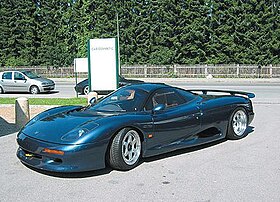Jaguar XJR-15
| Jaguar Sport XJR-15 | |
|---|---|
 |
|
| Overview | |
| Manufacturer | Jaguar Sport (TWR), Wycombe Mill, Bloxham, Oxon |
| Production | 1990-1992 (53 produced) |
| Designer | Peter Stevens and Tony Southgate |
| Body and chassis | |
| Class | Sports car (S) |
| Body style | 2-door coupé |
| Related | Jaguar XJR-9, Nissan R390 GT1 |
| Powertrain | |
| Engine | 6.0 L Jaguar V12 |
| Transmission | TWR 6 Speed manual |
| Dimensions | |
| Wheelbase | 2,718 mm (107.0 in) |
| Length | 4,800 mm (189.0 in) |
| Width | 1,900 mm (74.8 in) |
| Height | 1,100 mm (43.3 in) |
| Curb weight | 1,050–1,062 kg (2,315–2,341 lb) |
| Chronology | |
| Successor | Jaguar XJ220 |
The Jaguar Sport XJR-15 is a two-seater sports car produced by Jaguar Sport, a subsidiary of Jaguar and Tom Walkinshaw Racing between 1990 and 1992. Only 53 were made, each selling for US$960,165. Based mechanically on the Le Mans-winning Jaguar XJR-9, the car had an aerodynamic body designed by Tony Southgate and styled by Peter Stevens, who later went on to style the McLaren F1. The car featured in a 1-make racing series called the Jaguar Intercontinental Challenge, which supported 3 Formula 1 races (Monaco, Silverstone and Spa) in 1991. The $1m prize was won by Armin Hahne. XJR-15 was the World's first fully carbon-fibre road-car.
Tom Walkinshaw conceived the concept in 1988, following Jaguar's success at Le Mans, enlisting Peter Stevens to develop a road-going version of the XJR-9, originally designated as R-9R. A number of wealthy racing enthusiasts were keen to own such a car and pressed Walkinshaw into manufacturing a 'road going racer'. Original owners included Derek Warwick, Bob Wollek, Vern Schuppan, Matt Aitken, Andy Evans and the Sultan of Brunei.
In order to adapt the XJR-9 for road use, Stevens made a number of modifications to increase space and improve access. "Taking the race car as a base, we widened the cockpit by 75 mm (3.0 in) and raised the roof by 40 mm (1.6 in) to allow more headroom" he said, when interviewed in 1991. "The scale model was ready by Easter 1989, from there we went to clay...which was finished by October (1989). The first prototype was held up by Le Mans preparations but it was ready for Tom (Walkinshaw) to drive when he came back from France in July 1990."
...
Wikipedia
